Walbank F.W., Astin A.E., Frederiksen M.W., Ogilvie R.M. The Cambridge Ancient History, Volume 7, Part 1: The Hellenistic World
Подождите немного. Документ загружается.

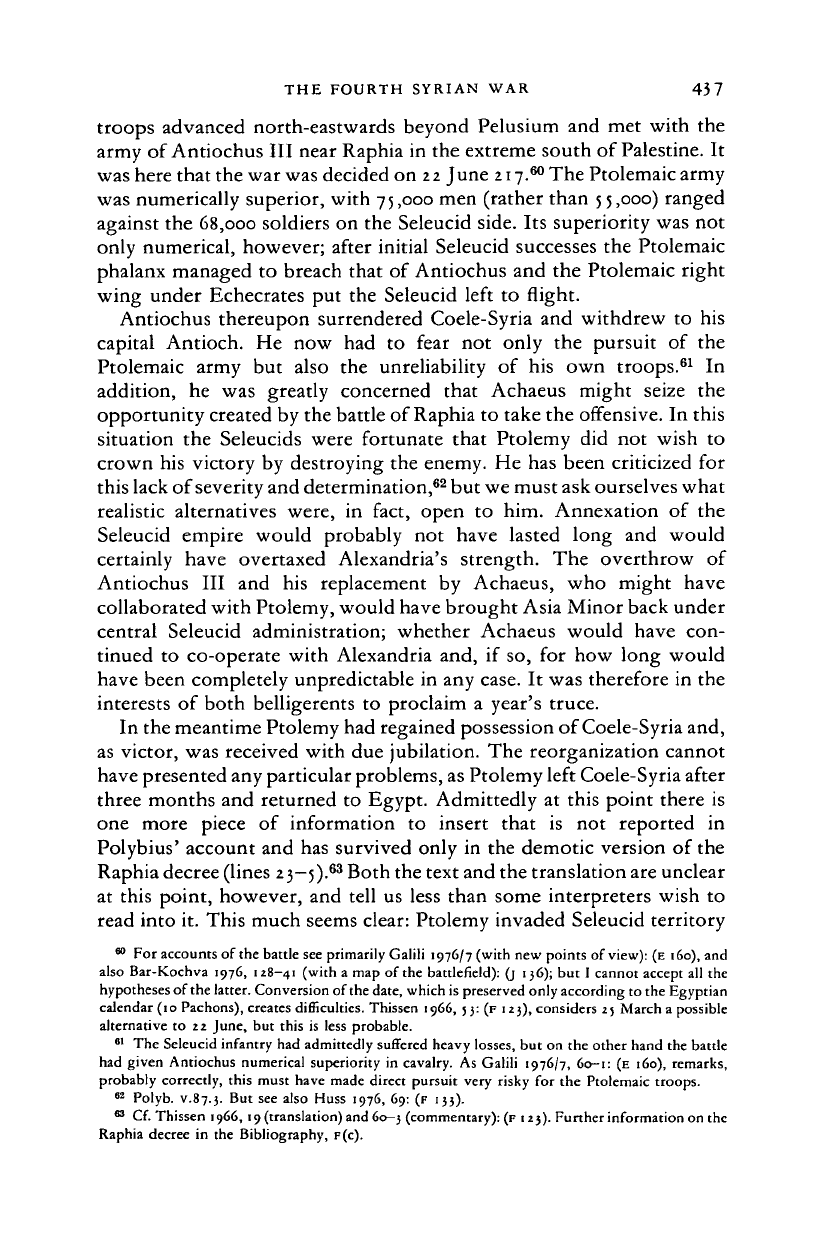
THE FOURTH SYRIAN WAR 437
troops advanced north-eastwards beyond Pelusium
and met
with
the
army
of
Antiochus
III
near Raphia
in
the extreme south
of
Palestine.
It
was here that the war was decided on 22 June 217.
m
The Ptolemaic army
was numerically superior, with 75,000 men (rather than
5
5,000) ranged
against the 68,000 soldiers
on the
Seleucid side.
Its
superiority was
not
only numerical, however; after initial Seleucid successes
the
Ptolemaic
phalanx managed
to
breach that
of
Antiochus
and the
Ptolemaic right
wing under Echecrates
put the
Seleucid left
to
flight.
Antiochus thereupon surrendered Coele-Syria
and
withdrew
to his
capital Antioch.
He
now had
to
fear
not
only
the
pursuit
of
the
Ptolemaic army
but
also
the
unreliability
of
his own
troops.
61
In
addition,
he
was
greatly concerned that Achaeus might seize
the
opportunity created by the battle
of
Raphia
to
take the offensive.
In
this
situation
the
Seleucids were fortunate that Ptolemy
did not
wish
to
crown his victory
by
destroying the enemy.
He
has been criticized
for
this lack of severity and determination,
62
but we must ask ourselves what
realistic alternatives were,
in
fact, open
to
him.
Annexation
of
the
Seleucid empire would probably
not
have lasted long
and
would
certainly have overtaxed Alexandria's strength.
The
overthrow
of
Antiochus
III and his
replacement
by
Achaeus,
who
might have
collaborated with Ptolemy, would have brought Asia Minor back under
central Seleucid administration; whether Achaeus would have
con-
tinued
to
co-operate with Alexandria
and,
if
so,
for how
long would
have been completely unpredictable
in
any case.
It
was therefore
in the
interests
of
both belligerents
to
proclaim
a
year's truce.
In the meantime Ptolemy had regained possession of Coele-Syria and,
as victor, was received with due jubilation.
The
reorganization cannot
have presented any particular problems, as Ptolemy left Coele-Syria after
three months
and
returned
to
Egypt. Admittedly
at
this point there
is
one more piece
of
information
to
insert that
is not
reported
in
Polybius' account
and
has survived only
in the
demotic version
of
the
Raphia decree (lines
23—5).
63
Both the text and the translation are unclear
at this point, however,
and
tell
us
less than some interpreters wish
to
read into it. This much seems clear: Ptolemy invaded Seleucid territory
60
For
accounts
of
the
battle
see
primarily Galili 1976/7 (with
new
points
of
view):
(E 160), and
also Bar-Kochva
1976,
128-41 (with
a
map
of
the
battlefield):
(j
136);
but
I
cannot accept
all the
hypotheses
of
the
latter. Conversion
of
the
date, which
is
preserved only according
to
the
Egyptian
calendar
(10
Pachons), creates difficulties. Thissen
1966, 53: (F 123),
considers
25
March
a
possible
alternative
to
22
June,
but
this
is
less probable.
61
The
Seleucid infantry
had
admittedly suffered heavy losses,
but on the
other hand
the
battle
had given Antiochus numerical superiority
in
cavalry.
As
Galili 1976/7,
60-1: (E 160),
remarks,
probably correctly, this must have made direct pursuit very risky
for the
Ptolemaic troops.
62
Polyb. v.87.3.
But see
also Huss 1976, 69: (F
133).
63
Cf. Thissen 1966,
19
(translation) and 60-3 (commentary):
(F
I
23).
Further information on the
Raphia decree
in the
Bibliography,
F(C).
Cambridge Histories Online © Cambridge University Press, 2008
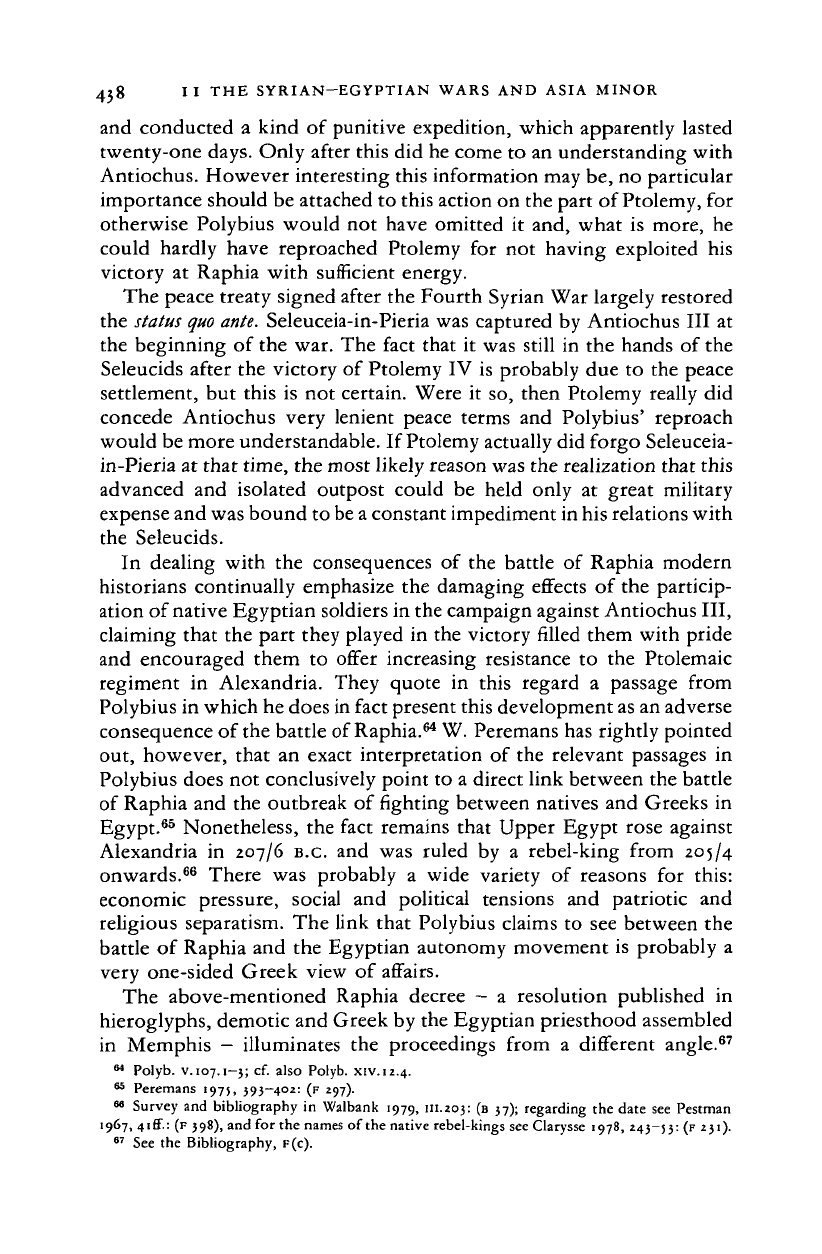
438 II THE SYRIAN-EGYPTIAN WARS AND ASIA MINOR
and conducted
a
kind
of
punitive expedition, which apparently lasted
twenty-one days. Only after this
did
he come
to an
understanding with
Antiochus. However interesting this information may be,
no
particular
importance should be attached
to
this action on the part
of
Ptolemy,
for
otherwise Polybius would
not
have omitted
it
and,
what
is
more,
he
could hardly have reproached Ptolemy
for not
having exploited
his
victory
at
Raphia with sufficient energy.
The peace treaty signed after the Fourth Syrian War largely restored
the
status
quo
ante.
Seleuceia-in-Pieria was captured
by
Antiochus
III at
the beginning
of
the war.
The
fact that
it
was still
in the
hands
of
the
Seleucids after
the
victory
of
Ptolemy
IV is
probably due
to the
peace
settlement,
but
this
is not
certain. Were
it
so, then Ptolemy really
did
concede Antiochus very lenient peace terms
and
Polybius' reproach
would be more understandable.
If
Ptolemy actually did forgo Seleuceia-
in-Pieria
at
that time, the most likely reason was the realization that this
advanced
and
isolated outpost could
be
held only
at
great military
expense and was bound to be
a
constant impediment in his relations with
the Seleucids.
In dealing with
the
consequences
of
the
battle
of
Raphia modern
historians continually emphasize
the
damaging effects
of
the particip-
ation
of
native Egyptian soldiers in the campaign against Antiochus III,
claiming that
the
part they played
in the
victory filled them with pride
and encouraged them
to
offer increasing resistance
to the
Ptolemaic
regiment
in
Alexandria. They quote
in
this regard
a
passage from
Polybius in which he does in fact present this development as an adverse
consequence
of
the battle of Raphia.
64
W. Peremans has rightly pointed
out, however, that
an
exact interpretation
of
the relevant passages
in
Polybius does
not
conclusively point
to a
direct link between the battle
of Raphia
and the
outbreak
of
fighting between natives
and
Greeks
in
Egypt.
65
Nonetheless,
the
fact remains that Upper Egypt rose against
Alexandria
in
207/6
B.C.
and was
ruled
by
a
rebel-king from 205/4
onwards.
66
There
was
probably
a
wide variety
of
reasons
for
this:
economic pressure, social
and
political tensions
and
patriotic
and
religious separatism. The link that Polybius claims
to see
between
the
battle
of
Raphia
and the
Egyptian autonomy movement
is
probably
a
very one-sided Greek view
of
affairs.
The above-mentioned Raphia decree
—
a
resolution published
in
hieroglyphs, demotic and Greek by the Egyptian priesthood assembled
in Memphis
-
illuminates
the
proceedings from
a
different angle.
67
64
Polyb.
v.
107.1—3;
cf.
also Polyb. xiv. 12.4.
65
Peremans 197), 393-402: (F 297).
M
Survey
and
bibliography
in
Walbank 1979,
in.203:
(B 37); regarding the date see Pestman
1967,
4iff.:
(F 398), and
for
the names
of
the native rebel-kings see Clarysse 1978, 243-53:
(F
231).
67
See
the
Bibliography,
F(C).
Cambridge Histories Online © Cambridge University Press, 2008
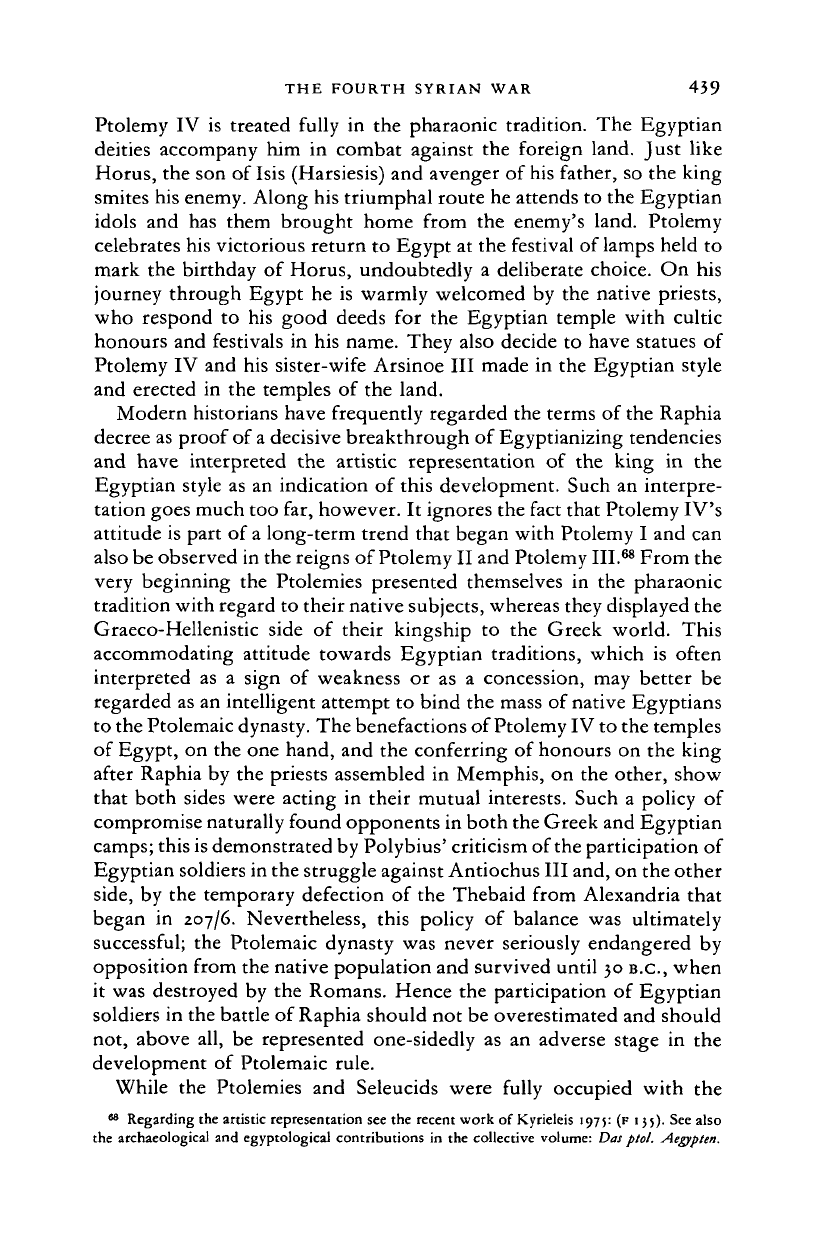
THE FOURTH SYRIAN WAR 459
Ptolemy IV is treated fully in the pharaonic tradition. The Egyptian
deities accompany him in combat against the foreign land. Just like
Horus, the son of Isis (Harsiesis) and avenger of his father, so the king
smites his enemy. Along his triumphal route he attends to the Egyptian
idols and has them brought home from the enemy's land. Ptolemy
celebrates his victorious return to Egypt at the festival of lamps held to
mark the birthday of Horus, undoubtedly a deliberate choice. On his
journey through Egypt he is warmly welcomed by the native priests,
who respond to his good deeds for the Egyptian temple with cultic
honours and festivals in his name. They also decide to have statues of
Ptolemy IV and his sister-wife Arsinoe III made in the Egyptian style
and erected in the temples of the land.
Modern historians have frequently regarded the terms of the Raphia
decree as proof of
a
decisive breakthrough of Egyptianizing tendencies
and have interpreted the artistic representation of the king in the
Egyptian style as an indication of this development. Such an interpre-
tation goes much too far, however. It ignores the fact that Ptolemy IV's
attitude is part of
a
long-term trend that began with Ptolemy I and can
also be observed in the reigns of Ptolemy II and Ptolemy III.
68
From the
very beginning the Ptolemies presented themselves in the pharaonic
tradition with regard to their native subjects, whereas they displayed the
Graeco-Hellenistic side of their kingship to the Greek world. This
accommodating attitude towards Egyptian traditions, which is often
interpreted as a sign of weakness or as a concession, may better be
regarded as an intelligent attempt to bind the mass of native Egyptians
to the Ptolemaic dynasty. The benefactions of Ptolemy IV to the temples
of Egypt, on the one hand, and the conferring of honours on the king
after Raphia by the priests assembled in Memphis, on the other, show
that both sides were acting in their mutual interests. Such a policy of
compromise naturally found opponents in both the Greek and Egyptian
camps; this is demonstrated by Polybius' criticism of the participation of
Egyptian soldiers in the struggle against Antiochus III and, on the other
side,
by the temporary defection of the Thebaid from Alexandria that
began in 207/6. Nevertheless, this policy of balance was ultimately
successful; the Ptolemaic dynasty was never seriously endangered by
opposition from the native population and survived until 30 B.C., when
it was destroyed by the Romans. Hence the participation of Egyptian
soldiers in the battle of Raphia should not be overestimated and should
not, above all, be represented one-sidedly as an adverse stage in the
development of Ptolemaic rule.
While the Ptolemies and Seleucids were fully occupied with the
68
Regarding the artistic representation see the recent work of Kyrieleis 1975: (F 135). See also
the archaeological and egyptological contributions in the collective volume:
Das
ptol. Aegypten.
Cambridge Histories Online © Cambridge University Press, 2008
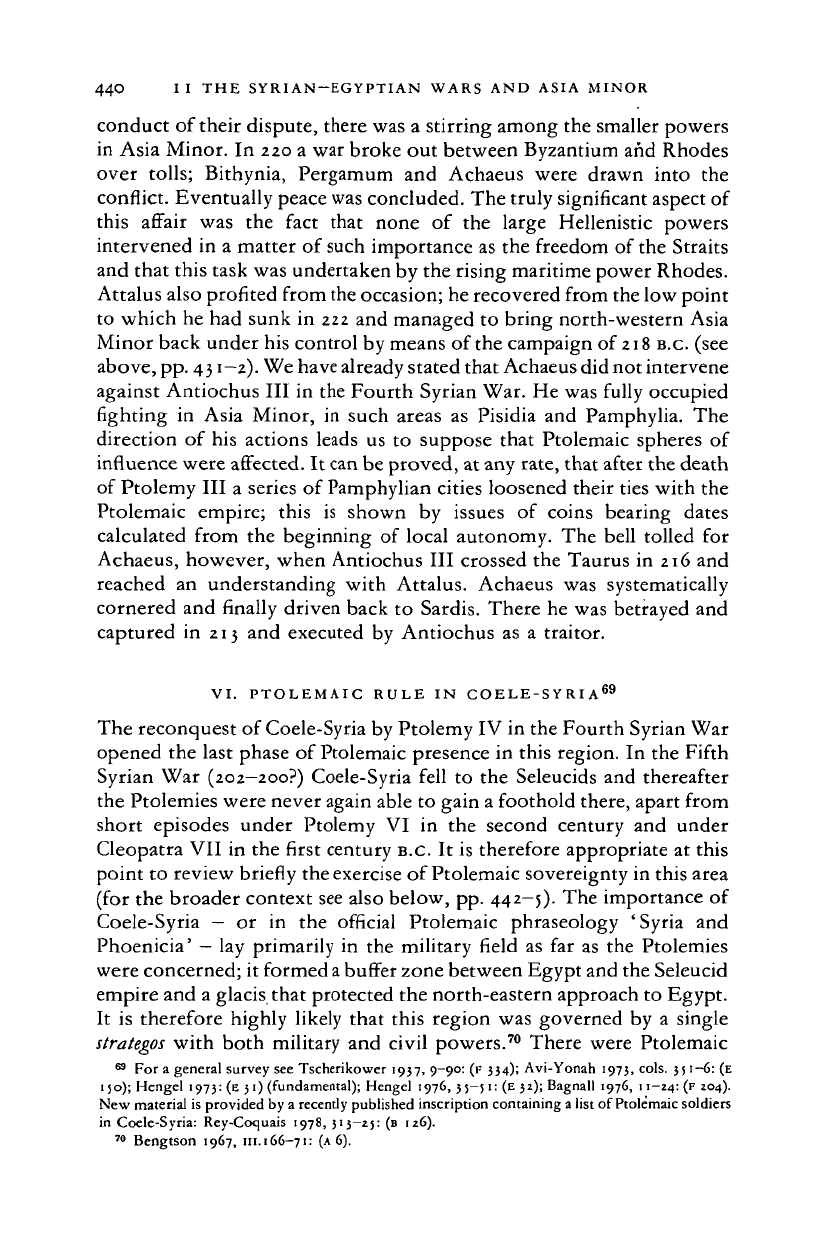
44O
II THE
SYRIAN—EGYPTIAN WARS
AND
ASIA MINOR
conduct of their dispute, there was a stirring among the smaller powers
in Asia Minor. In 220 a war broke out between Byzantium and Rhodes
over tolls; Bithynia, Pergamum
and
Achaeus were drawn into
the
conflict. Eventually peace was concluded. The truly significant aspect of
this affair was
the
fact that none
of
the large Hellenistic powers
intervened in a matter of such importance as the freedom of the Straits
and that this task was undertaken by the rising maritime power Rhodes.
Attalus also profited from the occasion; he recovered from the low point
to which he had sunk in 222 and managed to bring north-western Asia
Minor back under his control by means of the campaign of
218
B.C.
(see
above, pp.
431—2).
We have already stated that Achaeus did not intervene
against Antiochus III in the Fourth Syrian War. He was fully occupied
fighting in Asia Minor,
in
such areas
as
Pisidia and Pamphylia. The
direction
of
his actions leads us
to
suppose that Ptolemaic spheres of
influence were affected. It can be proved, at any rate, that after the death
of Ptolemy III a series of Pamphylian cities loosened their ties with the
Ptolemaic empire; this
is
shown
by
issues
of
coins bearing dates
calculated from the beginning
of
local autonomy. The bell tolled
for
Achaeus, however, when Antiochus III crossed the Taurus in 216 and
reached
an
understanding with Attalus. Achaeus was systematically
cornered and finally driven back to Sardis. There he was betrayed and
captured
in
213 and executed by Antiochus as
a
traitor.
VI.
PTOLEMAIC RULE IN COELE-SYRIA
69
The reconquest of Coele-Syria by Ptolemy IV in the Fourth Syrian War
opened the last phase of Ptolemaic presence in this region. In the Fifth
Syrian War (202—200?) Coele-Syria fell to the Seleucids and thereafter
the Ptolemies were never again able to gain a foothold there, apart from
short episodes under Ptolemy
VI
in
the
second century and under
Cleopatra VII in the first century B.C. It is therefore appropriate at this
point to review briefly the exercise of Ptolemaic sovereignty in this area
(for the broader context see also below, pp. 442-5). The importance of
Coele-Syria
—
or in
the
official Ptolemaic phraseology 'Syria
and
Phoenicia'
—
lay primarily in the military field as far as the Ptolemies
were concerned; it formed
a
buffer zone between Egypt and the Seleucid
empire and a glacis that protected the north-eastern approach to Egypt.
It is therefore highly likely that this region was governed by
a
single
strategos
with both military and civil powers.
70
There were Ptolemaic
69
For
a
general survey
see
Tscherikower
1937, 9~9°: (P 334);
Avi-Yonah 1973, cols. 551-6:
(E
iSo);Hengel 1973: (E
31)
(fundamental); Hengel
1976,
35-51:
(E
32);
Bagnall
1976,
11-24:
(F 204).
New material
is
provided
by
a
recently published inscription containing
a
list
of
Ptolemaic soldiers
in Coele-Syria: Rey-Coquais
1978,
313-25:
(B 126).
70
Bengtson
1967, m.i
66—71:
(A
6).
Cambridge Histories Online © Cambridge University Press, 2008
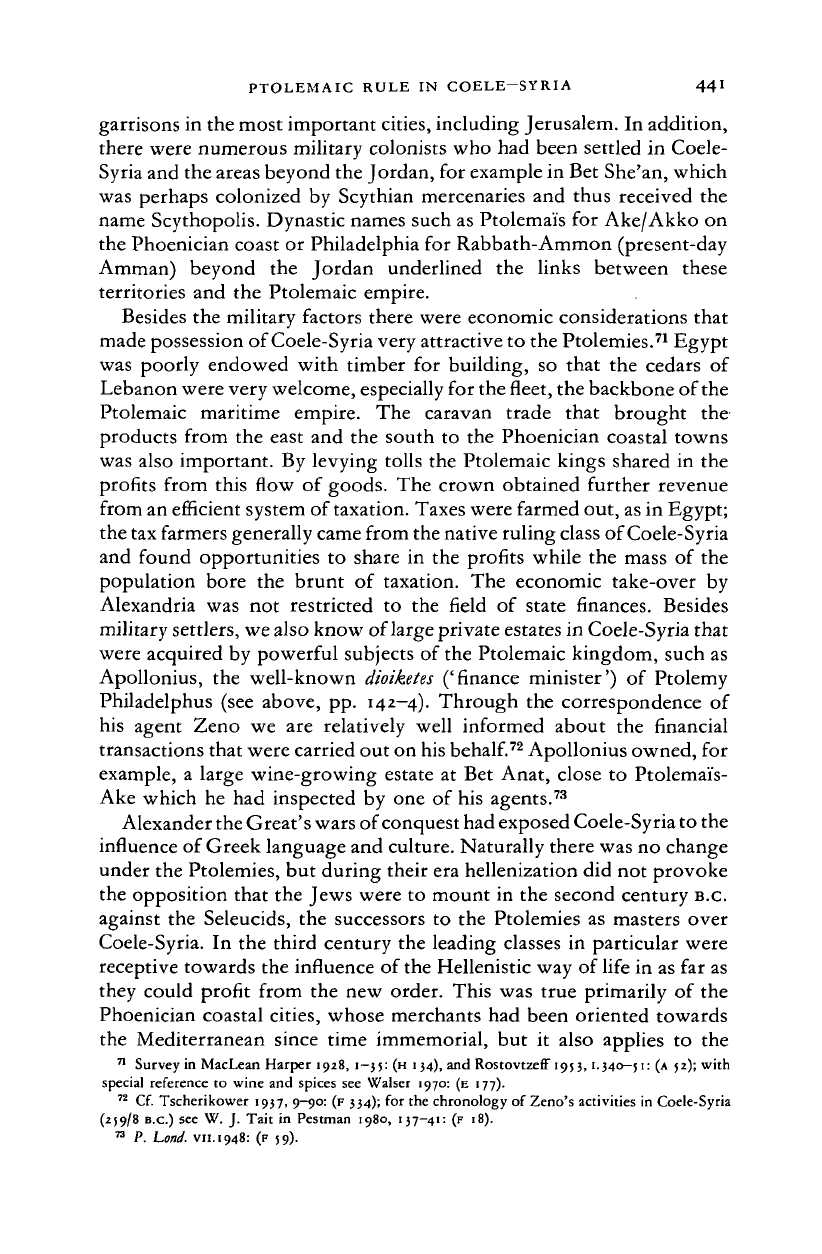
PTOLEMAIC RULE IN COELE-SYRIA 441
garrisons in the most important cities, including Jerusalem. In addition,
there were numerous military colonists who had been settled in Coele-
Syria and the areas beyond the Jordan, for example in Bet She'an, which
was perhaps colonized by Scythian mercenaries and thus received the
name Scythopolis. Dynastic names such as Ptolemai's for Ake/Akko on
the Phoenician coast or Philadelphia for Rabbath-Ammon (present-day
Amman) beyond
the
Jordan underlined
the
links between these
territories and the Ptolemaic empire.
Besides the military factors there were economic considerations that
made possession of Coele-Syria very attractive to the Ptolemies.
71
Egypt
was poorly endowed with timber for building, so that the cedars of
Lebanon were very welcome, especially for the fleet, the backbone of the
Ptolemaic maritime empire. The caravan trade that brought
the
products from the east and the south to the Phoenician coastal towns
was also important. By levying tolls the Ptolemaic kings shared in the
profits from this flow of goods. The crown obtained further revenue
from an efficient system of
taxation.
Taxes were farmed out, as in Egypt;
the tax farmers generally came from the native ruling class of Coele-Syria
and found opportunities to share in the profits while the mass of the
population bore the brunt
of
taxation. The economic take-over
by
Alexandria was not restricted
to
the field
of
state finances. Besides
military settlers, we also know of large private estates in Coele-Syria that
were acquired by powerful subjects of the Ptolemaic kingdom, such as
Apollonius, the well-known
dioiketes
('finance minister')
of
Ptolemy
Philadelphus (see above, pp. 142—4). Through the correspondence of
his agent Zeno we are relatively well informed about the financial
transactions that were carried out on his
behalf.
72
Apollonius owned, for
example, a large wine-growing estate at Bet Anat, close to Ptolemais-
Ake which he had inspected by one of his agents.
73
Alexander the Great's wars of conquest had exposed Coele-Syria to the
influence of Greek language and culture. Naturally there was no change
under the Ptolemies, but during their era hellenization did not provoke
the opposition that the Jews were to mount in the second century
B.C.
against the Seleucids, the successors to the Ptolemies as masters over
Coele-Syria. In the third century the leading classes in particular were
receptive towards the influence of the Hellenistic way of life in as far as
they could profit from the new order. This was true primarily of the
Phoenician coastal cities, whose merchants had been oriented towards
the Mediterranean since time immemorial, but
it
also applies
to
the
71
Survey in MacLean Harper 1928, 1—35: (H 134), and Rostovtzeff
1953,1.340—
JI:
(A 52); with
special
reference
to
wine and spices see Walser 1970: (E 177).
72
Cf. Tscherikower 1937, 9—90: (F 334); for the chronology of Zeno's activities in Coele-Syria
(259/8
B.C.)
see W.
J.
Tait
in
Pestman 1980,
137-41:
(F 18).
73
P.
LonJ.
VII.
1948: (F 59).
Cambridge Histories Online © Cambridge University Press, 2008
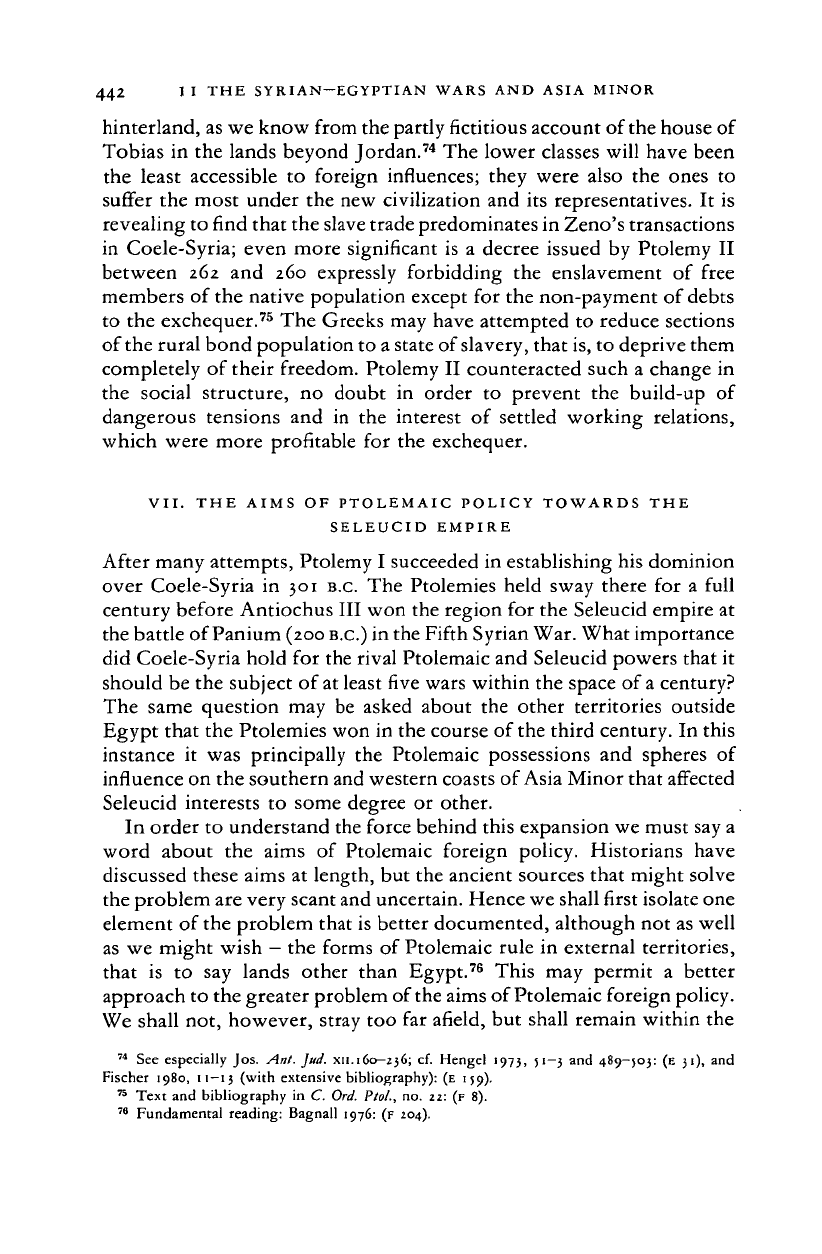
442
I I THE
SYRIAN—EGYPTIAN WARS
AND
ASIA MINOR
hinterland, as we know from the partly fictitious account of
the
house of
Tobias
in the
lands beyond Jordan.
74
The lower classes will have been
the least accessible
to
foreign influences; they were also
the
ones
to
suffer
the
most under
the
new civilization
and its
representatives.
It is
revealing to find that the slave trade predominates in Zeno's transactions
in Coele-Syria; even more significant
is a
decree issued
by
Ptolemy
II
between
262
and
260
expressly forbidding
the
enslavement
of
free
members
of
the native population except
for
the non-payment
of
debts
to
the
exchequer.
75
The Greeks may have attempted
to
reduce sections
of the rural bond population to a state of
slavery,
that
is,
to deprive them
completely
of
their freedom. Ptolemy
II
counteracted such
a
change
in
the social structure,
no
doubt
in
order
to
prevent
the
build-up
of
dangerous tensions
and in the
interest
of
settled working relations,
which were more profitable
for
the
exchequer.
VII.
THE AIMS OF PTOLEMAIC POLICY TOWARDS THE
SELEUCID EMPIRE
After many attempts, Ptolemy
I
succeeded
in
establishing his dominion
over Coele-Syria
in
301
B.C.
The
Ptolemies held sway there
for a
full
century before Antiochus
III
won the region
for
the Seleucid empire
at
the battle of Panium (200
B.C.)
in the Fifth Syrian War. What importance
did Coele-Syria hold
for
the rival Ptolemaic and Seleucid powers that
it
should
be
the subject
of
at least five wars within the space
of
a
century?
The same question
may
be
asked about
the
other territories outside
Egypt that the Ptolemies won
in
the course
of
the third century.
In
this
instance
it
was
principally
the
Ptolemaic possessions
and
spheres
of
influence on the southern and western coasts of Asia Minor that affected
Seleucid interests
to
some degree
or
other.
In order
to
understand the force behind this expansion we must say a
word about
the
aims
of
Ptolemaic foreign policy. Historians have
discussed these aims
at
length,
but
the ancient sources that might solve
the problem are very scant and uncertain. Hence we shall first isolate one
element
of
the problem that is better documented, although
not
as well
as
we
might wish
—
the
forms
of
Ptolemaic rule
in
external territories,
that
is to say
lands other than Egypt.
76
This
may
permit
a
better
approach to the greater problem of
the
aims
of
Ptolemaic foreign policy.
We shall not, however, stray
too far
afield,
but
shall remain within
the
74
See
especially
Jos.
Ant. ]ud.
xn.160—236;
cf.
Hengel
1973, 51—3
and
489-503:
(E 31),
and
Fischer
1980,
11-13 (with extensive bibliography): (E
159).
75
Text
and
bibliography
in C.
Ord.
Ptol.,
no.
22:
(F
8).
76
Fundamental reading: Bagnall
1976:
(F
204).
Cambridge Histories Online © Cambridge University Press, 2008
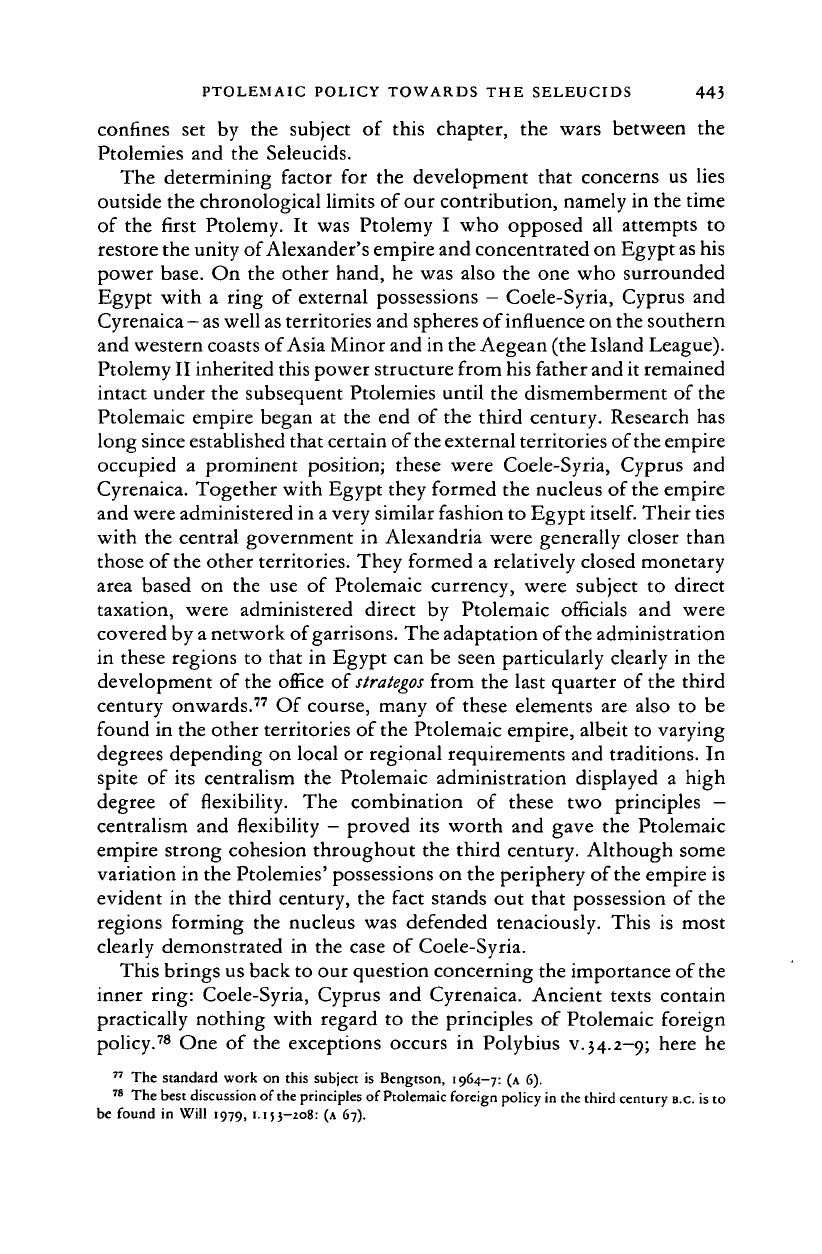
PTOLEMAIC POLICY TOWARDS THE SELEUCIDS 443
confines
set by the
subject
of
this chapter,
the
wars between
the
Ptolemies
and the
Seleucids.
The determining factor
for the
development that concerns
us
lies
outside the chronological limits of our contribution, namely in the time
of
the
first Ptolemy.
It
was
Ptolemy
I
who
opposed
all
attempts
to
restore the unity of Alexander's empire and concentrated on Egypt
as
his
power base.
On the
other hand,
he
was also
the one
who surrounded
Egypt with
a
ring
of
external possessions
-
Coele-Syria, Cyprus
and
Cyrenaica
—as
well
as
territories and spheres of influence on the southern
and western coasts of Asia Minor and in the Aegean (the Island League).
Ptolemy II inherited this power structure from his father and it remained
intact under the subsequent Ptolemies until the dismemberment
of
the
Ptolemaic empire began
at the end of
the third century. Research
has
long since established that certain of the external territories of the empire
occupied
a
prominent position; these were Coele-Syria, Cyprus
and
Cyrenaica. Together with Egypt they formed the nucleus of the empire
and were administered in
a
very similar fashion to Egypt
itself.
Their ties
with
the
central government
in
Alexandria were generally closer than
those
of
the other territories. They formed
a
relatively closed monetary
area based
on the use
of
Ptolemaic currency, were subject
to
direct
taxation, were administered direct
by
Ptolemaic officials
and
were
covered by a network of garrisons. The adaptation of the administration
in these regions
to
that
in
Egypt can
be
seen particularly clearly
in the
development
of
the office
of
strategos
from the last quarter
of
the third
century onwards.
77
Of
course, many
of
these elements
are
also
to be
found
in
the other territories
of
the Ptolemaic empire, albeit
to
varying
degrees depending
on
local
or
regional requirements and traditions.
In
spite
of
its
centralism
the
Ptolemaic administration displayed
a
high
degree
of
flexibility.
The
combination
of
these
two
principles
—
centralism
and
flexibility
—
proved
its
worth
and
gave
the
Ptolemaic
empire strong cohesion throughout
the
third century. Although some
variation in the Ptolemies' possessions
on
the periphery of
the
empire
is
evident
in the
third century,
the
fact stands
out
that possession
of
the
regions forming
the
nucleus
was
defended tenaciously. This
is
most
clearly demonstrated
in the
case
of
Coele-Syria.
This brings us back to our question concerning the importance of the
inner ring: Coele-Syria, Cyprus
and
Cyrenaica. Ancient texts contain
practically nothing with regard
to the
principles
of
Ptolemaic foreign
policy.
78
One
of
the
exceptions occurs
in
Polybius v.34.2—9; here
he
77
The standard work
on
this subject
is
Bengtson, 1964-7: (A
6).
78
The best discussion of the principles
of
Ptolemaic foreign policy in the third century
B.C.
is
to
be found
in
Will 1979, 1.153-208: (A
67).
Cambridge Histories Online © Cambridge University Press, 2008
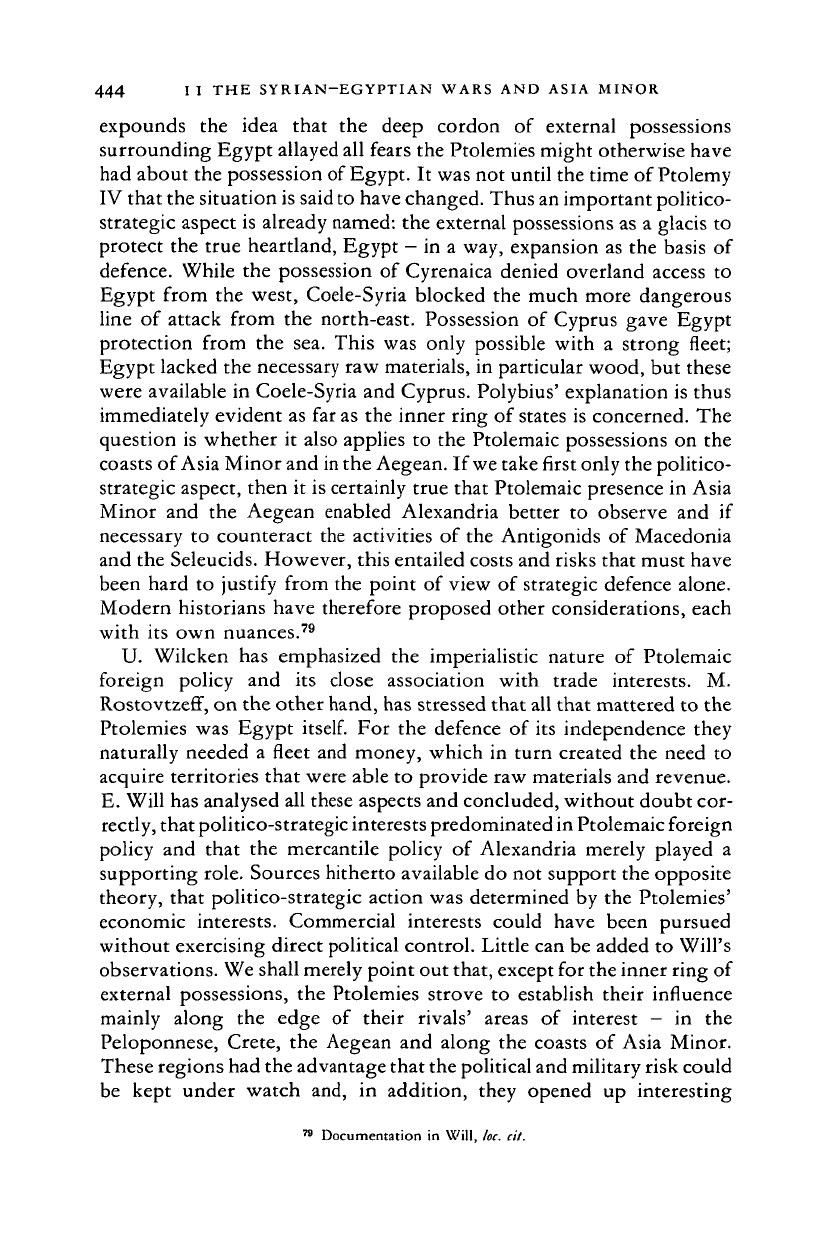
444 I I THE SYRIAN-EGYPTIAN WARS AND ASIA MINOR
expounds
the
idea that
the
deep cordon
of
external possessions
surrounding Egypt allayed all fears the Ptolemies might otherwise have
had about the possession of Egypt.
It
was not until the time of Ptolemy
IV that the situation is said to have changed. Thus an important politico-
strategic aspect is already named: the external possessions as
a
glacis
to
protect the true heartland, Egypt
-
in
a
way, expansion
as
the basis
of
defence. While
the
possession
of
Cyrenaica denied overland access
to
Egypt from
the
west, Coele-Syria blocked
the
much more dangerous
line
of
attack from
the
north-east. Possession
of
Cyprus gave Egypt
protection from
the sea.
This
was
only possible with
a
strong fleet;
Egypt lacked the necessary raw materials, in particular wood, but these
were available
in
Coele-Syria and Cyprus. Polybius' explanation is thus
immediately evident as far as the inner ring
of
states
is
concerned.
The
question
is
whether
it
also applies
to
the Ptolemaic possessions
on the
coasts of Asia Minor and
in
the Aegean. If we take first only the politico-
strategic aspect, then
it
is certainly true that Ptolemaic presence
in
Asia
Minor
and the
Aegean enabled Alexandria better
to
observe
and if
necessary
to
counteract the activities
of
the Antigonids
of
Macedonia
and the Seleucids. However, this entailed costs and risks that must have
been hard
to
justify from the point
of
view
of
strategic defence alone.
Modern historians have therefore proposed other considerations, each
with
its
own nuances.
79
U. Wilcken
has
emphasized
the
imperialistic nature
of
Ptolemaic
foreign policy
and its
close association with trade interests.
M.
Rostovtzeff, on the other hand, has stressed that all that mattered to the
Ptolemies
was
Egypt
itself.
For the
defence
of
its independence they
naturally needed
a
fleet and money, which
in
turn created
the
need
to
acquire territories that were able to provide raw materials and revenue.
E. Will has analysed all these aspects and concluded, without doubt cor-
rectly, that politico-strategic interests predominated in Ptolemaic foreign
policy
and
that
the
mercantile policy
of
Alexandria merely played
a
supporting role. Sources hitherto available do not support the opposite
theory, that politico-strategic action was determined
by
the Ptolemies'
economic interests. Commercial interests could have been pursued
without exercising direct political control. Little can be added
to
Will's
observations. We shall merely point out that, except for the inner ring of
external possessions,
the
Ptolemies strove
to
establish their influence
mainly along
the
edge
of
their rivals' areas
of
interest
—
in the
Peloponnese, Crete,
the
Aegean
and
along
the
coasts
of
Asia Minor.
These regions had the advantage that the political and military risk could
be kept under watch
and, in
addition, they opened
up
interesting
79
Documentation
in
Will, he.
cil.
Cambridge Histories Online © Cambridge University Press, 2008
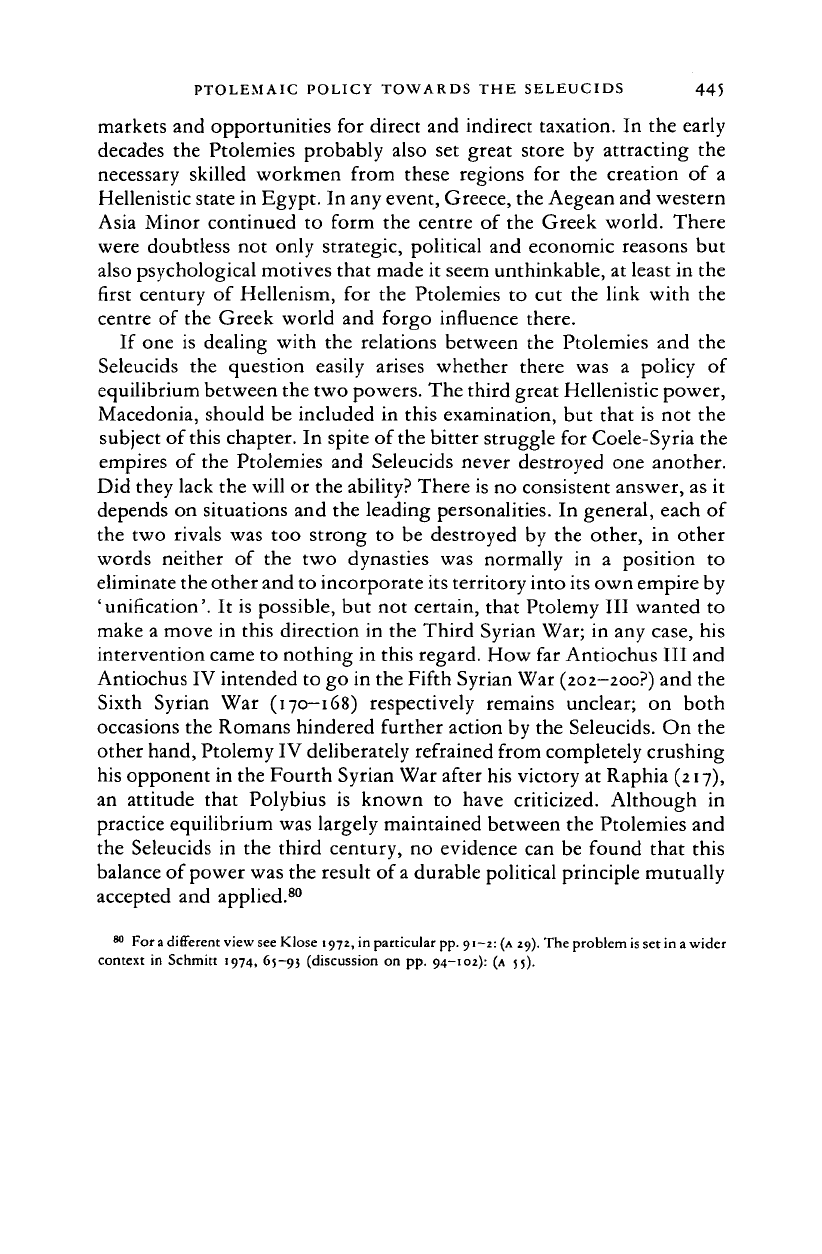
PTOLEMAIC POLICY TOWARDS THE SELEUCIDS 445
markets and opportunities for direct and indirect taxation. In the early
decades the Ptolemies probably also set great store by attracting the
necessary skilled workmen from these regions
for
the creation
of a
Hellenistic state in Egypt. In any event, Greece, the Aegean and western
Asia Minor continued
to
form the centre of the Greek world. There
were doubtless not only strategic, political and economic reasons but
also psychological motives that made it seem unthinkable, at least in the
first century of Hellenism, for the Ptolemies to cut the link with the
centre of the Greek world and forgo influence there.
If one
is
dealing with the relations between the Ptolemies and the
Seleucids
the
question easily arises whether there was
a
policy
of
equilibrium between the two powers. The third great Hellenistic power,
Macedonia, should be included in this examination, but that is not the
subject of
this
chapter. In spite of the bitter struggle for Coele-Syria the
empires of the Ptolemies and Seleucids never destroyed one another.
Did they lack the will or the ability? There is no consistent answer, as it
depends on situations and the leading personalities. In general, each of
the two rivals was too strong to be destroyed by the other,
in
other
words neither
of
the two dynasties was normally
in a
position
to
eliminate the other and to incorporate its territory into its own empire by
'unification'. It is possible, but not certain, that Ptolemy III wanted to
make a move in this direction in the Third Syrian War; in any case, his
intervention came to nothing in this regard. How far Antiochus III and
Antiochus IV intended to go in the Fifth Syrian War (202-200?) and the
Sixth Syrian War (170—168) respectively remains unclear;
on
both
occasions the Romans hindered further action by the Seleucids. On the
other hand, Ptolemy IV deliberately refrained from completely crushing
his opponent in the Fourth Syrian War after his victory at Raphia (217),
an attitude that Polybius
is
known
to
have criticized. Although
in
practice equilibrium was largely maintained between the Ptolemies and
the Seleucids in the third century, no evidence can be found that this
balance of power was the result of
a
durable political principle mutually
accepted and applied.
80
80
For a different view see Klose 1972, in particular pp. 91-2:
(A
29). The problem is set in a wider
context
in
Schmitt 1974, 65-93 (discussion
on
pp. 94-102): (A 55).
Cambridge Histories Online © Cambridge University Press, 2008
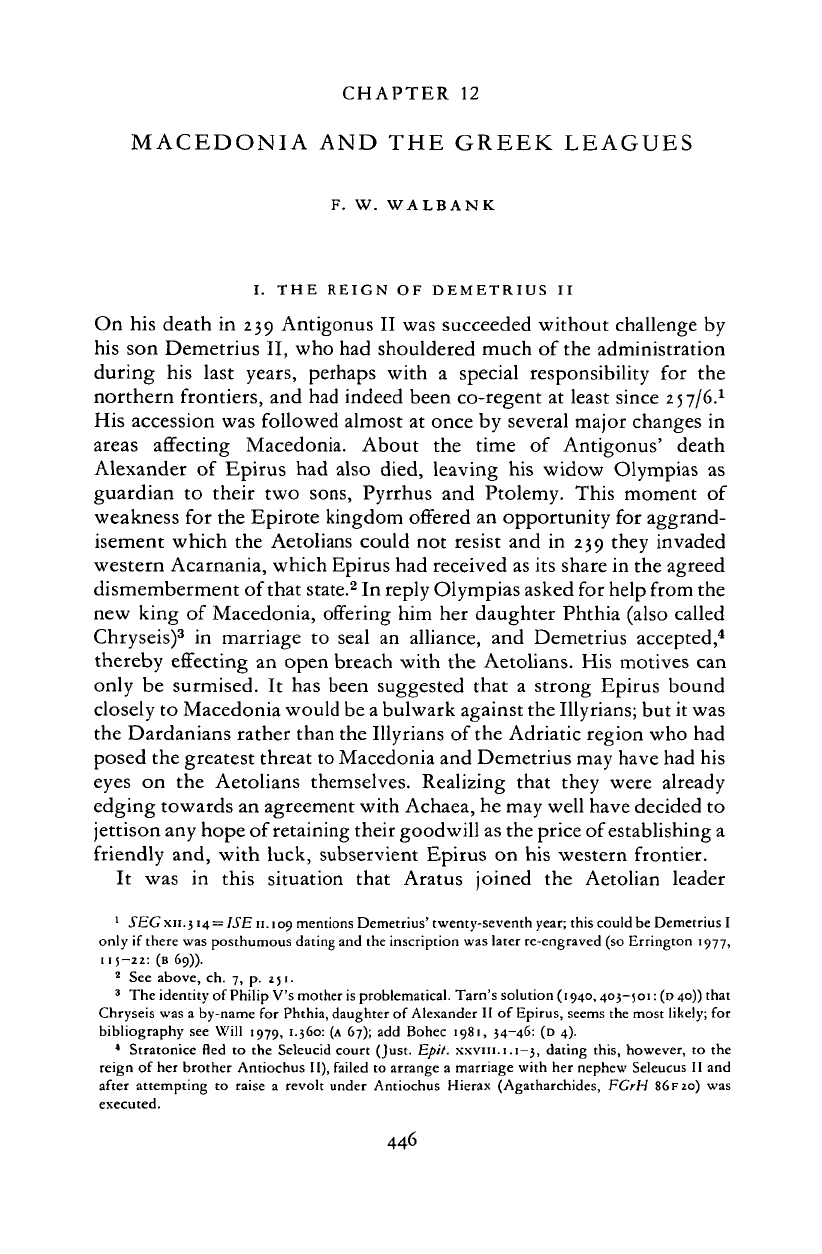
CHAPTER
12
MACEDONIA
AND THE
GREEK LEAGUES
F.
W. WALBANK
I. THE REIGN OF DEMETRIUS II
On his death
in
239 Antigonus
II
was succeeded without challenge by
his son Demetrius II, who had shouldered much
of
the administration
during
his
last years, perhaps with
a
special responsibility
for the
northern frontiers, and had indeed been co-regent
at
least since
25
7/6.
1
His accession was followed almost
at
once by several major changes
in
areas affecting Macedonia. About
the
time
of
Antigonus' death
Alexander
of
Epirus had also died, leaving
his
widow Olympias
as
guardian
to
their
two
sons, Pyrrhus
and
Ptolemy. This moment
of
weakness for the Epirote kingdom offered an opportunity for aggrand-
isement which the Aetolians could not resist and
in
239 they invaded
western Acarnania, which Epirus had received as its share in the agreed
dismemberment of that state.
2
In reply Olympias asked for help from the
new king
of
Macedonia, offering him her daughter Phthia (also called
Chryseis)
3
in
marriage
to
seal
an
alliance,
and
Demetrius accepted,
4
thereby effecting
an
open breach with the Aetolians. His motives can
only
be
surmised.
It
has been suggested that
a
strong Epirus bound
closely to Macedonia would be a bulwark against the IUyrians; but it was
the Dardanians rather than the IUyrians of the Adriatic region who had
posed the greatest threat to Macedonia and Demetrius may have had his
eyes
on the
Aetolians themselves. Realizing that they were already
edging towards an agreement with Achaea, he may well have decided
to
jettison any hope of retaining their goodwill as the price of establishing a
friendly and, with luck, subservient Epirus
on
his western frontier.
It
was in
this situation that Aratus joined
the
Aetolian leader
1
SEC
xii.
3 14
=
ISE 11.109 mentions Demetrius' twenty-seventh year; this could be Demetrius I
only
if
there was posthumous dating and the inscription was later re-engraved (so Errington 1977,
115-22:
(B
69)).
2
See above, ch.
7, p.
251.
3
The identity of Philip V's mother is problematical. Tarn's solution (1940,
403-501:
(D40)) that
Chryseis was
a
by-name
for
Phthia, daughter
of
Alexander
II of
Epirus, seems the most likely; for
bibliography see Will 1979,
1.360:
(A
67); add Bohec 1981, 34-46:
(D
4).
4
Stratonice fled
to
the
Seleucid court (Just. Epit. xxvm.
1.1—3,
dating this, however,
to
the
reign
of
her brother Antiochus II), failed to arrange
a
marriage with her nephew Seleucus
II
and
after attempting
to
raise
a
revolt under Antiochus Hierax (Agatharchides, FGrH 86F20)
was
executed.
446
Cambridge Histories Online © Cambridge University Press, 2008
